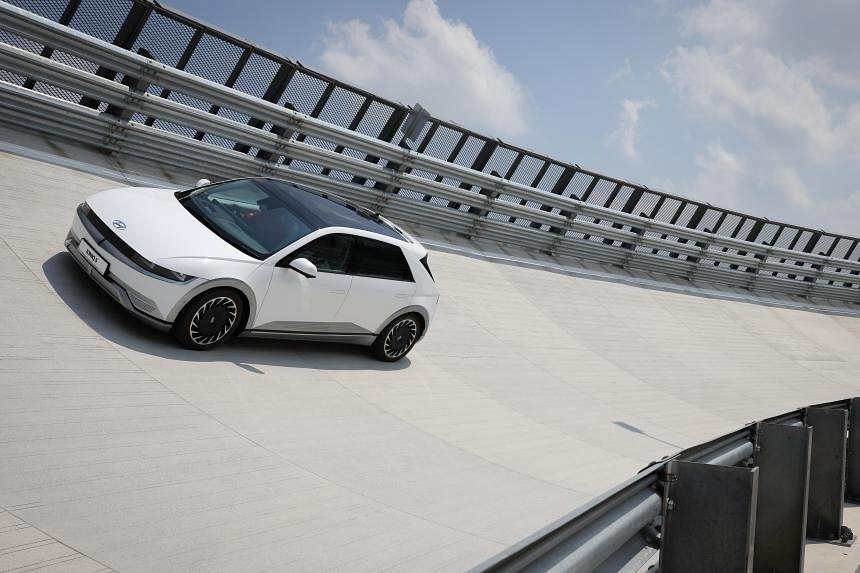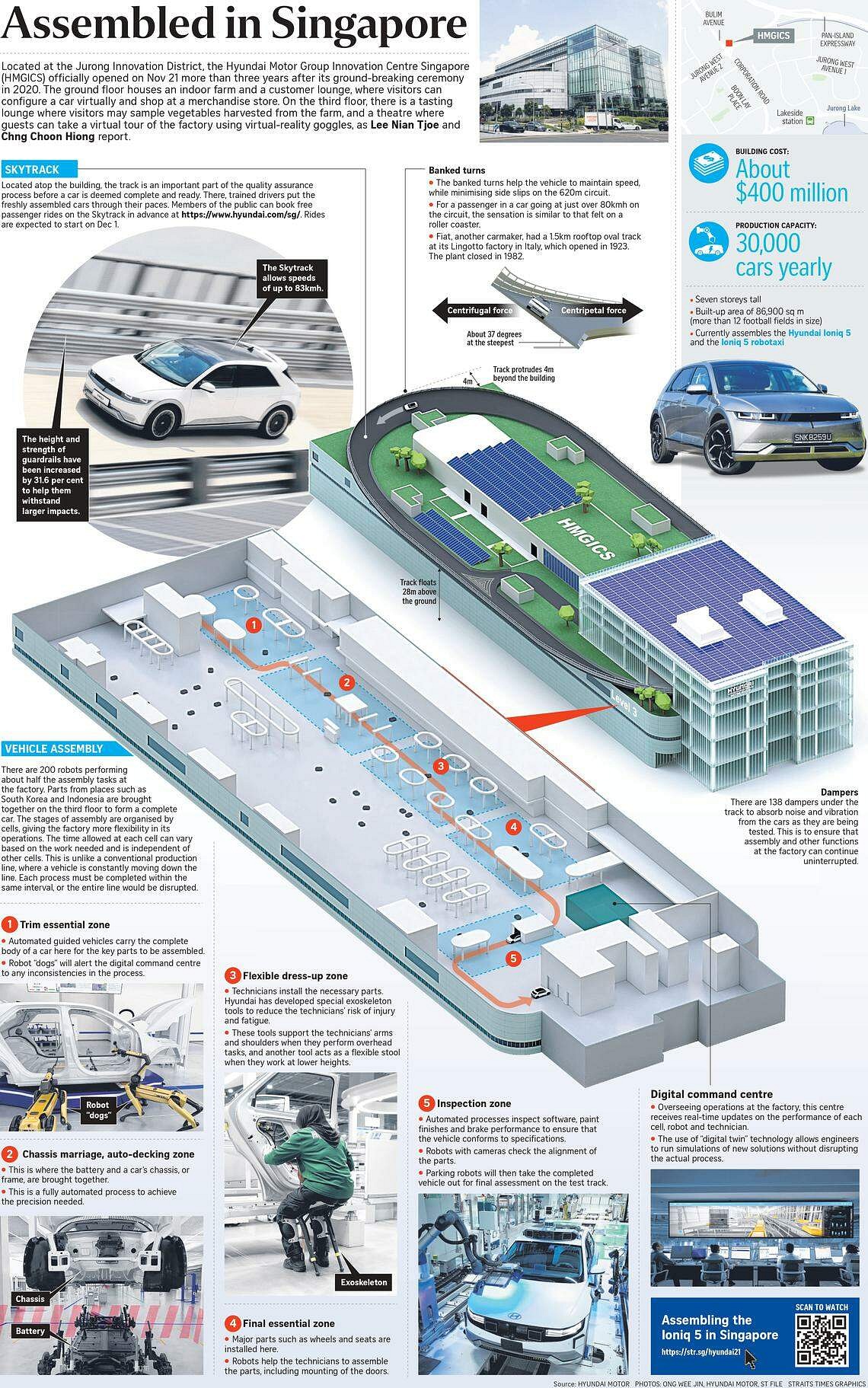SINGAPORE - The newly opened Hyundai Motor Group Innovation Centre Singapore (HMGICS) in Jurong Innovation District – Singapore’s first car assembly plant in four decades – is not just assembling Hyundai Ioniq 5 cars.
It is also equipping these electric crossovers with driverless technology to be used as so-called robotaxis in United States cities, starting with Las Vegas.
Mr Alpesh Patel, HMGICS’ vice-president and head of its technology innovation group, said the plant will produce 30 robotaxis in 2023 and 150 in 2024. Made in collaboration with automotive tech firm Aptiv, each one is equipped with more than 30 sensors, including Lidar (light detection and ranging), radar and cameras.
They have Level 4 autonomy, which means they can be driven hands-off and eyes-off for extended periods in various locations and situations. But for safety, a driver will still be on board for the taxi service in Las Vegas.
The $400 million assembly facility in Bulim Avenue started operations in early 2023, and was officially opened by Deputy Prime Minister Lawrence Wong on Nov 21.
DPM Wong said in his speech at the opening ceremony that HMGICS should “make full use of Singapore’s research capabilities and talents” to develop and pilot more novel solutions here.
“Together, we hope that we can push boundaries, create new value and create many more exciting and cutting-edge jobs for Singapore, and play a role in developing new vehicles and new solutions for the future.”
By the end of 2023, the highly automated facility would have assembled about 300 Ioniq 5 electric cars for Singapore customers, from parts shipped here from South Korea and Indonesia.
The facility, which has a planned capacity of 30,000 vehicles per year for local and overseas buyers, is likely to roll out more cars in 2024 as the certificate of entitlement supply in Singapore grows.
Mr Patel, a former aerodynamicist with Ferrari and previously a partner with consulting group McKinsey, said the Singapore plant will add the Ioniq 6 electric saloon to its highly automated assembly “within the next few months”, followed by “two or three other models”.
Besides cars, the plant can also assemble drones and two-wheelers.
The seven-storey 86,900 sq m facility boasts a flexible cell-based production system that breaks away from traditional conveyor-belt manufacturing. This modular system allows the plant to assemble several products at once, without the rigidity associated with a production line.

The facility acts as a test-bed for automating “general assembly” – a term used to describe the final part assembly where parts such as seats, the dashboard, air-conditioning, floor and roof linings are installed. This segment is currently largely manual, with up to 90 per cent of work done by people.
At HMGICS, about 50 per cent of work is done by 200 or so robots, and the percentage is expected to rise significantly with the assembly of so-called purpose-built vehicles – boxy, functional electric vehicles designed to be assembled with minimum human labour.
On its expansive production floor on the third level, there are only 30 technicians doing assembly work and 20 engineers doing jobs such as diagnostics, programming and maintenance. In total, the complex has 280 employees.

Each worker can be responsible for more than 50 tasks, compared with two or three in a traditional production line, according to Mr Patel.
Both robots and human workers are constantly monitored for efficiency and quality, with a team in an artificial intelligence-powered nerve centre overlooking the assembly area.
Robot “dogs” from Boston Dynamics – a US robot maker acquired by Hyundai in 2020 – patrol the production floor, peering into nooks and crannies looking for flaws.
DPM Wong said: “Workers don’t have to worry. There will still be enough jobs around for them, but we will reskill, upskill and make sure that they can take on higher-value jobs. So, it’s not about robots taking over humans, but humans and robots working together to create more value.”
“Ultimately, we want Singapore to always be a place where people can come together to imagine new possibilities,” he added.
Hyundai has not said when the plant’s production will reach its capacity of 30,000 a year. “Theoretically, we could do it tomorrow,” Mr Patel said, adding that the actual timing hinges mainly on demand.

Completed cars are taken to a 620m rooftop test track – the first of its kind in Asia. Complete with a 33-degree sloping section, it is designed to accommodate vehicles travelling at up to 83kmh. Cars are tested for a multitude of parameters, including noise, harshness and vibration.
Mr Patel said Hyundai Motor Group (which includes Kia) is looking to transplant this highly automated, labour-light concept tested in Singapore to its 45 manufacturing and assembly plants around the world.
But the HMGICS facility is more than a car assembly plant.
On two floors, vegetables such as ice plant and kale are grown in see-through fully automated hydroponic gardens where robots do everything from planting seeds to harvesting.
The vertical farms can produce 600 heads of vegetables a day, and Hyundai says this effort is in line with Singapore’s goal of becoming more self-sufficient in food supply.
The complex caters to car buyers and car enthusiasts, too. Like at similar showcases built by Volkswagen and Toyota, visitors can view cars being built, experience a chauffeured ride around the rooftop track, and if they buy a car, take delivery of it in an audio-visual hall where their vehicle is wheeled out by robotic trolleys.
From next April, a restaurant will open on the third floor.



